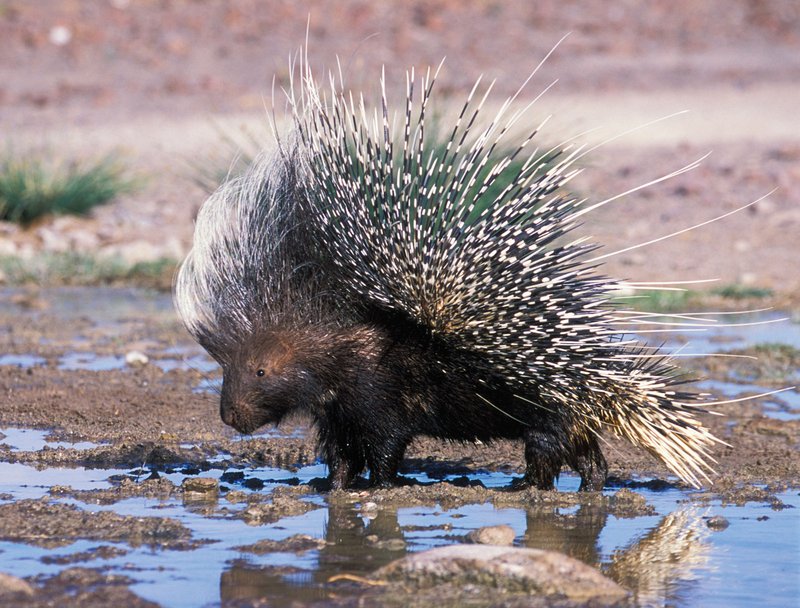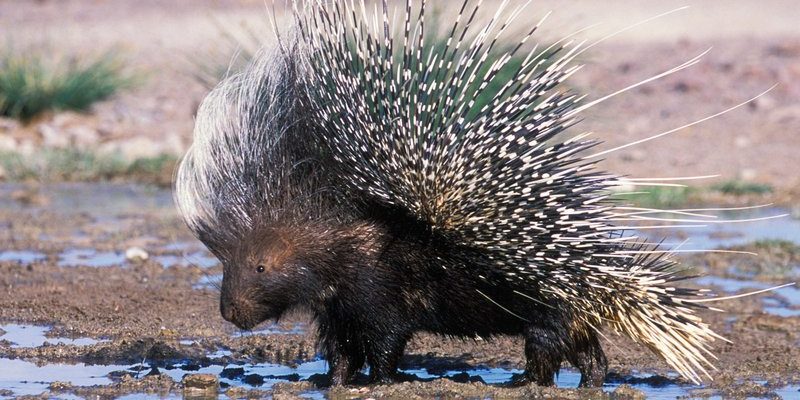
You might think of porcupines as those prickly little creatures you see in cartoons, but there’s so much more beneath their quilled exterior. These fascinating animals are not only intriguing but also play an important role in their ecosystems. Imagine them as nature’s defenders, armed with a unique set of quills that serve as both protection and an interesting conversation starter.
Porcupines belong to the rodent family and can be found across various habitats, from forests and deserts to grasslands. They are known for their remarkable ability to climb trees and for their nocturnal habits. If you’re curious about these creatures, you’re in for a treat—let’s dig deeper into their world and uncover some amazing facts!
Physical Characteristics
Porcupines are most famous for their iconic quills, which are modified hairs made of keratin—the same material found in our hair and nails. These quills can range from 8 to 12 inches in length and are often dark brown or black, sometimes with a striking white tip. When threatened, porcupines can raise these quills, making them look larger and more intimidating to potential predators.
Beyond their quills, porcupines have sturdy, compact bodies covered in coarse fur. They typically weigh between 10 to 40 pounds, depending on the species, with the North American porcupine being on the heavier side. Their eyes are small, but they possess a keen sense of smell and hearing, which helps them navigate their surroundings in the dark.
You may be surprised to learn that porcupines are quite agile, especially for their size. They are excellent climbers, often spending a significant portion of their lives in trees. This ability not only helps them escape from predators but also provides access to their primary food sources like leaves, fruits, and bark.
Habitat and Distribution
Porcupines are found in diverse habitats across North America, South America, and Africa. In North America, they prefer wooded areas, forests, and even shrublands, while their South American relatives can be found in rainforests. The African porcupines often inhabit savannas and grasslands. Each habitat offers an abundance of food and shelter, which is vital for their survival.
Let’s take a look at a few interesting facts about where porcupines live:
| Region | Common Habitat | Species |
| North America | Forests, rocky areas | North American Porcupine |
| South America | Rainforests, grasslands | Brazilian Porcupine |
| Africa | Savannas, scrublands | African Crested Porcupine |
This diversity in habitat underscores just how adaptable porcupines are. They can thrive in various environments, which has allowed them to spread and establish populations in different regions. Their adaptability is also evident in their diet, which can change based on seasonal food availability.
Diet and Feeding Habits
Porcupines are herbivores, meaning they primarily feast on plants. Their diet mainly consists of leaves, fruits, flowers, and the inner bark of trees. Interestingly, they have a particular fondness for certain trees, like birch and pine, which offer not only food but also shelter.
You might be wondering how such a prickly animal goes about its eating. Well, porcupines use their strong, chisel-like front teeth to gnaw through tough bark, making their way to the softer inner layers. They have a slower digestion process, which allows them to extract the necessary nutrients from their fibrous diet. This slow metabolism also means they spend a lot of time foraging!
In the colder months, when food becomes scarce, porcupines may rely on stored food or the bark of trees, ensuring they have enough to eat until spring arrives. Their foraging habits play a role in their ecosystems by helping to disperse seeds, which aids in plant growth.
Behavior and Social Structure
Porcupines are mainly solitary animals. They prefer to roam alone, except during the breeding season or when a mother is nurturing her young. Males and females typically come together only to mate, usually between late summer and early fall. After a gestation period of about 30 to 40 weeks, the female gives birth to one or two porcupettes, who are surprisingly well-developed and can even climb shortly after birth!
Though porcupines are generally shy creatures, they have a few social behaviors worth noting. When threatened, they often resort to various defense mechanisms. Instead of attacking, they may hiss, stomp their feet, and give warning sounds, trying to scare off potential threats. If that doesn’t work, they’ll turn their back and raise their quills—a clear signal that they’re not to be messed with.
It’s important to recognize that porcupines are not aggressive by nature. Most attacks occur when they feel cornered or threatened. If you happen to encounter one in the wild, it’s best to give them space and observe from a distance.
Conservation Status
While porcupines are generally not facing immediate threats, some species are more vulnerable than others. For example, in certain regions where their habitats are being impacted by deforestation or urban development, porcupine populations can decline. Conservation efforts are essential to protect these creatures and their habitats.
Organizations and wildlife agencies actively work to monitor porcupine populations and educate the public about preserving their natural environments. Simple steps like planting native trees and reducing habitat destruction can go a long way in ensuring porcupines remain a part of our ecosystems.
Being aware of the challenges these animals face is crucial to fostering a compassionate approach toward wildlife. So, whether it’s participating in local clean-up efforts or spreading the word about the importance of conservation, every little bit helps!
Interesting Facts About Porcupines
Ever wonder what makes porcupines truly unique? Here are some fun facts that might surprise you:
- Porcupines can have up to 30,000 quills on their bodies!
- They are primarily nocturnal, meaning they are most active at night.
- Despite common belief, porcupines cannot throw their quills. Instead, they detach easily when a predator makes contact.
- Porcupines have an excellent sense of smell, allowing them to locate food and potential mates from a distance.
These little quirks only make porcupines more endearing. It’s hard not to appreciate their unique adaptations and behaviors that help them thrive in the wild.
FAQ
What do porcupines eat?
Porcupines are herbivores, meaning they primarily eat plant material. Their diet usually includes leaves, fruits, flowers, and tree bark. They particularly enjoy the inner bark of trees, where they can obtain nutrients during different seasons. This herbivorous diet helps them maintain healthy lifestyles and supports their ecosystems.
Are porcupines dangerous to pets?
While porcupines are not inherently aggressive, they can pose a risk to pets. If a dog or cat approaches a porcupine, they may end up getting quills stuck in their face or body. It’s important for pet owners to keep their animals supervised outdoors, especially in areas where porcupines are known to live.
How do porcupines defend themselves?
Porcupines have a unique way of defending themselves: they rely on their quills. When threatened, they raise their quills and may hiss or make warning sounds to deter predators. If those methods fail, they will turn their backs to the threat, raising their quills to show that they are not an easy target.
Do porcupines hibernate?
Porcupines do not hibernate in the traditional sense. Instead, they remain active during winter but may reduce their activity levels and rely on stored food or bark from trees. This behavior allows them to survive in colder climates without entering a deep hibernation.
Where do porcupines live?
Porcupines are quite adaptable and can be found in various habitats. In North America, they prefer forests, shrublands, and rocky areas. South American porcupines can often be found in rainforests, while African species inhabit savannas and grasslands. Their wide distribution reflects their flexibility in adapting to different environments.
What is the lifespan of a porcupine?
The typical lifespan of a porcupine in the wild is around 7 to 10 years, though some may live longer in captivity. Their longevity can be influenced by factors such as predation, habitat, and food availability. Unfortunately, they face risks from various predators, which can affect their overall survival rates.
Can porcupines climb trees?
Yes, porcupines are excellent climbers! Their strong limbs and sharp claws make it easy for them to scale trees. This ability not only helps them escape from predators but also allows them to access food sources that are higher off the ground, such as leaves and fruits.
Are porcupines solitary animals?
Yes, porcupines are generally solitary creatures. They prefer to live alone, coming together only to mate or raise their young. This solitary behavior allows them to be less vulnerable to predators, as they are less conspicuous than social species.
How do porcupines communicate?
Porcupines communicate through a mix of vocalizations and body language. They may grunt, hiss, or make other sounds to express their feelings or warn off threats. Additionally, their posture, especially when they raise their quills, sends a clear message about their intentions and feelings.
Can porcupines swim?
Yes, porcupines are capable swimmers! They have been known to swim across rivers and lakes when necessary. Their quills, though not buoyant, do not hinder their swimming ability, allowing them to navigate through the water when needed.
What role do porcupines play in their ecosystem?
Porcupines play a crucial role in their ecosystem by acting as herbivores. They help control plant growth by feeding on various vegetation, which can encourage new plant development. Additionally, as they move through their environment, they help disperse seeds and contribute to forest regeneration.

